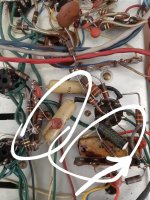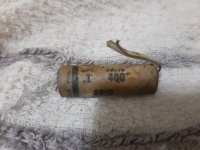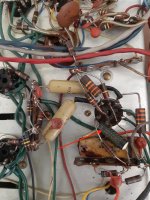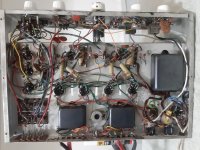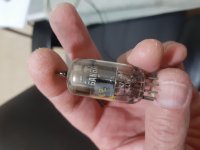So I got this sweet-sounding Vidaire Catalina amp, it's based on EL84/12AX7 and in a good condition. I've cleaned the chassis, contacts, sockets, pots, resoldered some cold joints, and it's basically working but has some issues and I would appreciate some help on this.
This is the model appearing here:
Vidaire "Catalina" Stereo Vacuum Tube Integrated Amplifier Made on Long Island 1961 - YouTube
The issues are:
1. Connected to my small Tannoy Mercury S speakers (using the 8ohm outs), no sound issues. But when I connect it to the bigger Tannoy SRM12X, I'm getting heavy thumping and oscillation noises as I turn the main volume knob up and down. If I only connect the left speaker, no issue. If I only connect the right speaker it would oscillate. If I connect both, there's an oscillation in both.
But sometimes there would be no noise/oscillation at all with the SRM12X...
I've made a video here:
20211205_115728.mp4 - Google Drive
2. When the amp is connected to the main 220v power, I might get mild electric shock when trying to connect an RCA cable to either of its inputs, but not always. But if I try to connect its Tape Out to my Quad 303 Line In, the main power in my house would turn off immediately (electric shock protection). Just connecting the amp to power and touching the chassis, there's no shock... and if I monitor the Tape Out voltage with DMM, it reads somewhere around 2 volts. Monitoring the speaker out voltage, I'm getting this:
20211205_121018.mp4 - Google Drive
3. Right channel becomes louder than left channel as you turn the main volume knob past its middle position. I'm pretty sure all tube contacts are ok
4. I'm trying to figure out the correct replacement parts/values for the electrolytic caps.
There's one big paper cap on each channel, rated 0.1uf/400v, but also smaller caps rated as well 0.1uf/400v... why there are smaller and bigger caps then, if they are all the same values?
Here are some pics:
20211204_222728.jpg - Google Drive
20211204_231354.jpg - Google Drive
https://drive.google.com/file/d/1CyNGjWrjWgGAva6ceVOP9PM0Ol5Lb-ZD/view?usp=sharing
Schematics of what's supposed to be the same up under a different name, but I don't see this one uses the same type of tube so I'm not sure...
https://drive.google.com/file/d/11iRkcN44YfeWW04ZwgIeUKcE_gsBSm15/view?usp=sharing
Here's a short video I took for a loose wire I detected and fixed, which also shows the circuit, so might help:
https://drive.google.com/file/d/1D_IJNwwZT-mGRbgt61T-iRLC0ObFChTa/view?usp=sharing
Thanks for any assistance.
This is the model appearing here:
Vidaire "Catalina" Stereo Vacuum Tube Integrated Amplifier Made on Long Island 1961 - YouTube
The issues are:
1. Connected to my small Tannoy Mercury S speakers (using the 8ohm outs), no sound issues. But when I connect it to the bigger Tannoy SRM12X, I'm getting heavy thumping and oscillation noises as I turn the main volume knob up and down. If I only connect the left speaker, no issue. If I only connect the right speaker it would oscillate. If I connect both, there's an oscillation in both.
But sometimes there would be no noise/oscillation at all with the SRM12X...
I've made a video here:
20211205_115728.mp4 - Google Drive
2. When the amp is connected to the main 220v power, I might get mild electric shock when trying to connect an RCA cable to either of its inputs, but not always. But if I try to connect its Tape Out to my Quad 303 Line In, the main power in my house would turn off immediately (electric shock protection). Just connecting the amp to power and touching the chassis, there's no shock... and if I monitor the Tape Out voltage with DMM, it reads somewhere around 2 volts. Monitoring the speaker out voltage, I'm getting this:
20211205_121018.mp4 - Google Drive
3. Right channel becomes louder than left channel as you turn the main volume knob past its middle position. I'm pretty sure all tube contacts are ok
4. I'm trying to figure out the correct replacement parts/values for the electrolytic caps.
There's one big paper cap on each channel, rated 0.1uf/400v, but also smaller caps rated as well 0.1uf/400v... why there are smaller and bigger caps then, if they are all the same values?
Here are some pics:
20211204_222728.jpg - Google Drive
20211204_231354.jpg - Google Drive
https://drive.google.com/file/d/1CyNGjWrjWgGAva6ceVOP9PM0Ol5Lb-ZD/view?usp=sharing
Schematics of what's supposed to be the same up under a different name, but I don't see this one uses the same type of tube so I'm not sure...
https://drive.google.com/file/d/11iRkcN44YfeWW04ZwgIeUKcE_gsBSm15/view?usp=sharing
Here's a short video I took for a loose wire I detected and fixed, which also shows the circuit, so might help:
https://drive.google.com/file/d/1D_IJNwwZT-mGRbgt61T-iRLC0ObFChTa/view?usp=sharing
Thanks for any assistance.
Last edited:
Better to post the pictures here.
I assume you mean 120V not 220V for AC supply voltage or are you not in the U.S.
There is a real safety issue here, you need to identify the source of the short between the amp's internal ground and the AC line voltage. Until you do you should not plug it into the AC mains. (Is there a death cap from mains to chassis - if so remove it.) This is an ELECTROCUTION HAZARD.
You may want to use an isolation transformer and a ballast lamp while testing and troubleshooting.
How much experience do you have and have you read through the safety threads here?
The caps are different sizes possibly due to a difference in the dielectric used, metallized or foil construction, etc. (Assuming same brand)
I assume you mean 120V not 220V for AC supply voltage or are you not in the U.S.
There is a real safety issue here, you need to identify the source of the short between the amp's internal ground and the AC line voltage. Until you do you should not plug it into the AC mains. (Is there a death cap from mains to chassis - if so remove it.) This is an ELECTROCUTION HAZARD.
You may want to use an isolation transformer and a ballast lamp while testing and troubleshooting.
How much experience do you have and have you read through the safety threads here?
The caps are different sizes possibly due to a difference in the dielectric used, metallized or foil construction, etc. (Assuming same brand)
Thanks. I've checked this and found that the outlet plug wires were reversed, so the hot wire was connected to the death cap. Do you recommend removing that yellow death cap and make a new outlet 3 prong cable with ground wire connected to chassis?
or just replace the death cap with something else?
btw, running at 220v here (europe)
how do I test to make sure there's no short between AC and ground while disconnected? this way I can also test to see if the cap is the cause for the short before removing it, and verify there's no short and it's safe to connect the amp, once the cap is removed...
also, do you think this short is the cause for the oscillation through the bigger speakers?
And would you recommend just replacing all bigs 0.1uf/400v caps?
Are the smaller ones non-polarized while the bigger one is polarized, which explains them being different?
Do these older caps have "better" sound?
For some reason image upload doesn't work for me, so here are links:
Google Drive: Sign-in
20211206_030738 (1).jpg - Google Drive
20211206_030722.jpg - Google Drive
Thanks again
or just replace the death cap with something else?
btw, running at 220v here (europe)
how do I test to make sure there's no short between AC and ground while disconnected? this way I can also test to see if the cap is the cause for the short before removing it, and verify there's no short and it's safe to connect the amp, once the cap is removed...
also, do you think this short is the cause for the oscillation through the bigger speakers?
And would you recommend just replacing all bigs 0.1uf/400v caps?
Are the smaller ones non-polarized while the bigger one is polarized, which explains them being different?
Do these older caps have "better" sound?
For some reason image upload doesn't work for me, so here are links:
Google Drive: Sign-in
20211206_030738 (1).jpg - Google Drive
20211206_030722.jpg - Google Drive
Thanks again
Last edited:
Hi gilwe,
Deal with the "death cap" properly. It got it's name for a reason. Do measure any leakage current afterwards and if excessive you need a new power transformer, or at least an isolation transformer. No kidding around with this.
I'm not going to address rebuild specifics or improvements now. Fix the dangerous issues before doing anything else.
-Chris
Deal with the "death cap" properly. It got it's name for a reason. Do measure any leakage current afterwards and if excessive you need a new power transformer, or at least an isolation transformer. No kidding around with this.
I'm not going to address rebuild specifics or improvements now. Fix the dangerous issues before doing anything else.
-Chris
1) remove the death cap (any cap connecting any mains prong to chassis) NOW.
No Ifs or Buts.
2) remove original mains cable and replace it with a 3 wire one, with Hot and Neutral going to "old wire" terminal points and Ground wire firmly attached to chassis on its own terminal.
Make it 5 cm longer than others so if cable is pulled hard, others break/disconnect first and Ground wire last.
3) have a Certified Electrician install a grounded 3 pin outlet, so it´s *guaranteed* ground terminal works as it should.
4) only AFTER that you can continue testing/modding/Upgrading/listening it safely.
No Ifs or Buts.
2) remove original mains cable and replace it with a 3 wire one, with Hot and Neutral going to "old wire" terminal points and Ground wire firmly attached to chassis on its own terminal.
Make it 5 cm longer than others so if cable is pulled hard, others break/disconnect first and Ground wire last.
3) have a Certified Electrician install a grounded 3 pin outlet, so it´s *guaranteed* ground terminal works as it should.
4) only AFTER that you can continue testing/modding/Upgrading/listening it safely.
Thanks all.
I removed the death cap, replaced the two prong cable with 3 prong one and connected the ground prong to chassis. There were a few contact issues that I had to solve while at it, but now it works, I can connect the Tape Out to my Quad 303 without any electric shock or issues, the balance between the two channels is correct even with the main volume knob at max. So I assume the main hazard issue is solved by now. I found that one leg of the big filter cap was too close to the chassis, slightly touching it, and while this leg seems to go to ground anyway, I made sure it's far enough from the chassis, just in case.
But the oscillation/noise/thumping issue though the big Tannoy SRM12X is still here. There's no hum/noise when connecting the small Tannoy Mercury S.
What could this be? bad caps maybe?
I was also wondering about the types of the 0.1uf/400v caps around the 12AX7 tubes.
One type is smaller, I was wondering if the smaller yellow ones are non-polarized, while the bigger yellow one is an electrolyte/polarized? it does have a black ring mark on it... The electronic parts store seller is confident the bigger one is also non-polarized, but I doubt it :/
I removed the death cap, replaced the two prong cable with 3 prong one and connected the ground prong to chassis. There were a few contact issues that I had to solve while at it, but now it works, I can connect the Tape Out to my Quad 303 without any electric shock or issues, the balance between the two channels is correct even with the main volume knob at max. So I assume the main hazard issue is solved by now. I found that one leg of the big filter cap was too close to the chassis, slightly touching it, and while this leg seems to go to ground anyway, I made sure it's far enough from the chassis, just in case.
But the oscillation/noise/thumping issue though the big Tannoy SRM12X is still here. There's no hum/noise when connecting the small Tannoy Mercury S.
What could this be? bad caps maybe?
I was also wondering about the types of the 0.1uf/400v caps around the 12AX7 tubes.
One type is smaller, I was wondering if the smaller yellow ones are non-polarized, while the bigger yellow one is an electrolyte/polarized? it does have a black ring mark on it... The electronic parts store seller is confident the bigger one is also non-polarized, but I doubt it :/
Attachments
Last edited:
The .1 400v is non-polarized. They are well known for getting a little leaky.
You want to replace them with orange drop poly of the same values.
Also measure the assorted resistors in case anything has drifted.
You want to replace them with orange drop poly of the same values.
Also measure the assorted resistors in case anything has drifted.
... but then the other 4 other yellow caps read 0.1uf 400v as well, so why did they use different caps of the same rating? Are the 4 smaller yellow ones different from the 2 bigger ones? Can I replace all 6 with the same, new 0.1uf 400v caps or should I use different types of caps in each location?
Balance issue came back btw...
Balance issue came back btw...
Last edited:
Does that .1/400 v cap just connect across the 30 mfd/30 volt cap? Not seeing the .1 in the schematic, which does not match the photo. I take it this device does not have a balance pot on the output stage.
The other four may be higher tolerance caps. You want them to match well or bad things like low frequency oscillation can happen. Maybe see if you can get a picture of them.
It may also be worth drawing the schematic from what you see there.
The 470K resistors need to match along with the 33K 1watt resistors. They are 5% rated according to the gold band on them.
If you do not have a good capacitance meter, I would just replace them with decent caps.
It may also be worth drawing the schematic from what you see there.
The 470K resistors need to match along with the 33K 1watt resistors. They are 5% rated according to the gold band on them.
If you do not have a good capacitance meter, I would just replace them with decent caps.
Hi gilwe,
Time to back off, relax and do some reading on restoration of tube equipment. I know you are excited to complete this, but it would seem you need to learn a few things first. Take some time.
You have old electronics. Some resistors will be way out of tolerance by now and need replacement. Different types of resistors are better than others for specific jobs. Also, pay attention to the break down voltage ratings as modern resistors can vary from 50 VDC to 500 VDC. Wire commonly available is rated for 300 VDC, you may need 600 VDC wire in some places. I wouldn't know without examining the schematic. Coupling capacitors are critical. Use decent quality ones, but make sure they are axial leaded (radials don't fit in the same locations) and that they are the same size physically or smaller than the originals.
Take pictures first! Lots of pictures. The new components should be in the same positions as the original ones.
Lastly, filter capacitors are often bad. If the seal is broken / ruptured, it is bad. Do not increase the value in uF of the capacitor. Use parts that fit in the same location and do not connect new capacitors across the terminals of the old ones! Pull the old part completely.
-Chris
Time to back off, relax and do some reading on restoration of tube equipment. I know you are excited to complete this, but it would seem you need to learn a few things first. Take some time.
You have old electronics. Some resistors will be way out of tolerance by now and need replacement. Different types of resistors are better than others for specific jobs. Also, pay attention to the break down voltage ratings as modern resistors can vary from 50 VDC to 500 VDC. Wire commonly available is rated for 300 VDC, you may need 600 VDC wire in some places. I wouldn't know without examining the schematic. Coupling capacitors are critical. Use decent quality ones, but make sure they are axial leaded (radials don't fit in the same locations) and that they are the same size physically or smaller than the originals.
Take pictures first! Lots of pictures. The new components should be in the same positions as the original ones.
Lastly, filter capacitors are often bad. If the seal is broken / ruptured, it is bad. Do not increase the value in uF of the capacitor. Use parts that fit in the same location and do not connect new capacitors across the terminals of the old ones! Pull the old part completely.
-Chris
As mentioned in the comments to the video, that amp was actually manufactured by Shell Electronics and rebranded. The Shell version is called the Manhasset 2020P. Schematics and owner's manual can be downloaded from HiFiEngine for free, you just need to register.So I got this sweet-sounding Vidaire Catalina amp, it's based on EL84/12AX7 and in a good condition. . . .
HiFi Engine | Owners and Service Manuals
Yeah I already have these. At this point I don't think I'm going for full refurbishment. The main hazard issue seems solved, so atm I'm mainly at sorting out the oscillation/noise issue which happens only when I connect the amp to the big Tannoy. Do you guys have any suggestions?
So it appears one of the 6AN8 is bad. Swapping the two 6AN8 the oscillation switches channels. Might also be responsible for the balance issue.
i would heed Anatech's advice a unit this old will assuredly have bad supply filter caps.
as to the amp misbehaving with the Big Reds it comes down to difference in current draw not all speakers have the same impedance curve and with a likely marginal supply oscillation can be a few milliamps difference at the right frequency and bam your amps an oscillator!
as to the amp misbehaving with the Big Reds it comes down to difference in current draw not all speakers have the same impedance curve and with a likely marginal supply oscillation can be a few milliamps difference at the right frequency and bam your amps an oscillator!
"Motor boating" is usually a failed electrolytic cap. The best way to find it is to scope the capacitors, but the quick way is to shunt them with a new cap. This is a bit dangerous and causes sparks. Fortunately, tubes are hard to blow up.
I've noticed there's a burn mark at the top of one of those 6AN8, bad tube?
I only see one polarized cap around each of those 6AN8, rated "50uf 3VDC". Should I just try to replace it and with what kind of cap/ratings?
I only see one polarized cap around each of those 6AN8, rated "50uf 3VDC". Should I just try to replace it and with what kind of cap/ratings?
Attachments
- Home
- Amplifiers
- Tubes / Valves
- Help fixing a 60s Vidaire Catalina stereo amp
